the 2007 Abstract Presentations - Wound Healing Society
the 2007 Abstract Presentations - Wound Healing Society
the 2007 Abstract Presentations - Wound Healing Society
Create successful ePaper yourself
Turn your PDF publications into a flip-book with our unique Google optimized e-Paper software.
<strong>Abstract</strong>s<br />
122<br />
SEQUENTIAL APPROACH OF ANTI-BACTERIAL, ANTI-<br />
INFLAMMATORY, AND GROWTH FACTOR DRESSINGS IN<br />
THE HEALING OF STALLED CHRONIC WOUNDS<br />
A. Alavi 1,2 , P. Coutts 2 , M. Fierheller 2 , Sibbald R.G. 1,2<br />
1 University of Toronto, Toronto, ON, Canada,<br />
2 Dermatology and wound healing clinic, Mississauga, ON, Canada<br />
Background: The treatment of chronic wounds represents a major cost to<br />
society, and has profound effects on <strong>the</strong> subjects’ quality of life.<br />
Objectives: We evaluated <strong>the</strong> use of a sequential advanced dressing protocol<br />
and growth factor approach to stimulate stalled chronic wounds into a healing<br />
trajectory. This study examined <strong>the</strong> signs and symptoms of critical colonization<br />
as a determinant of choice of dressing.<br />
Methods: A total of 29 patients with chronic wounds (10 patients with diabetes,<br />
10 patients with venous disease and 9 patients with miscellaneous wounds) were<br />
treated for eight weeks with ei<strong>the</strong>r a silver releasing hydro-alginate dressing<br />
(Silvercel ) or an oxidized regenerated cellulose/collagen plus 1% ionized silver<br />
(Prisma ). The first dressing choice was made based on <strong>the</strong> presence of bacterial<br />
balance (colonization) or increased bacterial burden in <strong>the</strong> superficial compartment<br />
(critical colonization). After four weeks, those with a healing trajectory<br />
received ei<strong>the</strong>r a Platelets derived growth factor (Regranex ) or an oxidized<br />
regenerated cellulose/collagen (Promogran ) until complete healing or week 8.<br />
Results: All patients completed <strong>the</strong> study. Five out of 29 patients (17%) healed.<br />
There is not statistically significant difference between sequential and non<br />
sequential use of dressing in this study. The healing rate was <strong>the</strong> same in three<br />
different groups (DNFU, VSU, and Misc). Silvercel outperformed in bacterial<br />
colonization reduction in compare with Prisma (p-value o 0.05).<br />
Conclusion: This study suggests <strong>the</strong> use of advanced dressings with antiinflammatory<br />
and ionized silver components are effective in establishing a<br />
healing trajectory in <strong>the</strong> management of critically colonized wounds. However;<br />
sequential use needs fur<strong>the</strong>r study. These agents are beneficial for chronic<br />
wounds with a stalled healing trajectory.<br />
Key words: wound, silvercel, prima, regranex, promogran, prospective.<br />
Acknowledgments: The funding of <strong>the</strong> study is provided by Johnson and<br />
Johnson.<br />
123<br />
DIABETIC FOOT ULCERS IN KERMAN, IRAN:<br />
PROSPECTIVE, DESCRIPTIVE REVIEW<br />
A. Alavi 1,2 , M. Sanjari 1 , A. Haghdoost 1 , R.G. Sibbald 2<br />
1 University of Kerman, Kerman, Iran,<br />
2 University of Toronto, Toronto, ON Canada<br />
Background: Diabetes is a common chronic disease with many complications<br />
including foot ulcers and potential non traumatic loss of a limb that causes a<br />
considerable human suffering and pain. In Iran, over 2 million of people are<br />
affected with diabetes mellitus and <strong>the</strong>re is a high risk of amputation in this<br />
population. We evaluated to study <strong>the</strong> feet of PWD attending an outpatient<br />
Diabetic clinic to identify important characteristics of <strong>the</strong> foot as a guide to <strong>the</strong><br />
development of foot clinics and <strong>the</strong> prevention of amputations in PWD.<br />
Methods: A prospective, descriptive, clinic-based study was conducted on 247<br />
patients with diabetes mellitus. The objectives of <strong>the</strong> study were to define <strong>the</strong><br />
clinical features of <strong>the</strong> foot examination in persons with diabetes (PWD) and<br />
<strong>the</strong> correlation of callus formation and o<strong>the</strong>r foot abnormalities have been<br />
reviewed.<br />
Results: The mean age of patients with diabetes (PWD) has been reported<br />
52 12. Iranian patients with diabetes are young population with more recent<br />
onset of diabetes. The prevalence of callus in <strong>the</strong> enrolled patients was 12% and<br />
heel cracks were noted in 50%. There was a significant relationship between<br />
callus and presence of hammer toe, ulceration and <strong>the</strong> absence of tibialis<br />
posterior pulse (with odd’s ratio of 4, 3, and 5 respectively). The prevalence of<br />
foot ulcer in PWD was 4%.<br />
Conclusion: A diabetic screening program will help to identify PWD at high<br />
risk of ulcer formation. This program will facilitate early management to<br />
decrease <strong>the</strong> morbidity, loss of limbs and mortality.<br />
Key words: diabetic foot ulcer, wound, Iran, case studies, prospective, descriptive,<br />
callus.<br />
124<br />
A MULTI-CENTER RETROSPECTIVE REVIEW OF THE USE<br />
OF A HUMAN ACELLULAR DERMAL REGENERATIVE<br />
TISSUE MATRIX FOR THE MANAGEMENT OF DIABETIC<br />
LOWER EXTREMITY WOUNDS<br />
Brock A. Liden, DPM 1 , Christopher L. Winters, DPM 2 , Stephen A. Brigido,<br />
DPM 3 , Melitta Simmons, DPM 1 , Jodi F. Hartman, MS 4 , and Michelle L.<br />
Wright, BS 5<br />
This multi-center study presents <strong>the</strong> use of a human acellular dermal regenerative<br />
tissue matrix as an alternative treatment for 100 chronic, full-thickness<br />
wounds of <strong>the</strong> lower extremity in 75 diabetic patients. Co-morbidities included<br />
neuropathy (86.0%), cardiac disease (86.0%), peripheral vascular disease<br />
(82.0%), infection (54.0%), obesity (51.0%), and osteomyelitis (37.0%).<br />
<strong>Wound</strong> locations included <strong>the</strong> foot (86.0%), ankle (8.0%), and lower extremity<br />
(6.0%). Mean wound age was 20.4 weeks (1.3–191.4). University of Texas<br />
<strong>Wound</strong> classifications included 15 (15.0%) 1A, 1 (1.0%) 1B, 1 (1.0%) 1C, 2<br />
(2.0%), 1D, 18 (18.0%) 2A, 8 (8.0%) 2B, 5 (5.0%) 2C, 3 (3.0%) 2D, 3 (3.0%)<br />
3A, 7 (7.0%) 3B, 3 (3.0%) 3C, and 34 (34.0%) 3D. Mean time to graft<br />
incorporation, 100% granulation, and complete healing was 1.5 weeks<br />
(0.43–4.4), 5.1 weeks (0.43–16.7), and 13.8 weeks (1.7–57.8), respectively.<br />
Overall graft success rate was 90.0%. One failed wound subsequently healed<br />
approximately 7 weeks after graft reapplication. The healing rate was 91.0%, as<br />
91 of <strong>the</strong> 100 wounds healed. No statistically significant differences were<br />
observed between UT classifications and times to graft incorporation, 100%<br />
granulation, and complete healing. Absence of graft-related complications and<br />
high rates of closure in a wide array of diabetic wounds suggest that this graft is<br />
a viable treatment for complex lower extremity wounds. Lack of any statistically<br />
significant differences between UT grades and wound outcome endpoints<br />
lends fur<strong>the</strong>r support to <strong>the</strong> universal applicability of this graft, with successful<br />
results in both superficial diabetic wounds and in wounds penetrating to <strong>the</strong><br />
bone or joint. A grant was received by Wright Medical Technology, Inc.<br />
125<br />
WOUND COMPLICATIONS FOLLOWING SURGICAL<br />
REVASCULARIZATION OF THE LOWER EXTREMITY: ROLE<br />
FOR HBO2T<br />
Irfan Qureshi MD, and George A. Perdrizet MD, PhD<br />
FACS Hartford Hospital Center for <strong>Wound</strong> <strong>Healing</strong> and Hyperbaric<br />
Medicine, University of Connecticut, Hartford, CT<br />
Introduction: Vascular surgery for patients with critical limb ischemia is a<br />
common practice. Successful surgery is often accompanied by improved blood<br />
flow to <strong>the</strong> foot at <strong>the</strong> expense of creating a surgical wound in a compromised<br />
lower leg. Hyperbaric oxygen <strong>the</strong>rapy (HBO2T) may offer an option to assist<br />
<strong>the</strong> healing of <strong>the</strong>se surgical wounds.<br />
Methods: Case report<br />
Results: A 71 y white male with Type II diabetes mellitus and a surgical wound<br />
dehiscence of a right tibial bypass site presents to <strong>the</strong> hospital two months<br />
following successful in situ saphenous vein bypass graft from <strong>the</strong> popliteal<br />
artery to <strong>the</strong> distal anterior tibial artery for an ischemic right foot and<br />
gangrenous toes. Post-operative day 30, <strong>the</strong> distal surgical wound dehisced<br />
with exposure of <strong>the</strong> arterialized venous graft. Local wound care, bed rest and<br />
systemic antibiotics and surgical options for closure had failed. The distal ray<br />
amputation sites were healing, reflecting <strong>the</strong> success of <strong>the</strong> revascularization<br />
procedure. HBO2T was initiated on post-operative day 46 (2.4 ATA,<br />
90 min.qd). Comprehensive wound care techniques were implemented including<br />
local moist wound care, topical antimicrobial ointment, nutritional <strong>the</strong>rapy<br />
and tight blood sugar control. By <strong>the</strong> 20 th treatment granulation tissue began to<br />
appear within <strong>the</strong> wound bed and <strong>the</strong> patient was successfully closed with a<br />
split-thickness skin graft one week following completion of HBO2T. At 11<br />
months follow up <strong>the</strong> patient is alive and well with a patent bypass graft and<br />
intact skin graft.<br />
Conclusions: HBO2T was used to successfully treat wound healing complications<br />
associated with high risk peripheral vascular surgical procedures.<br />
<strong>Wound</strong> Rep Reg (<strong>2007</strong>) 15 A14–A54 c <strong>2007</strong> by <strong>the</strong> <strong>Wound</strong> <strong>Healing</strong> <strong>Society</strong><br />
A47




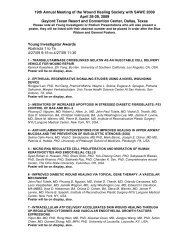

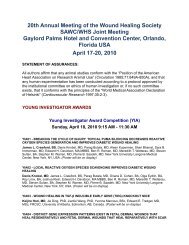
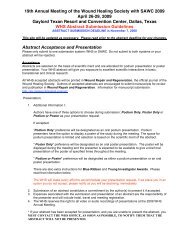
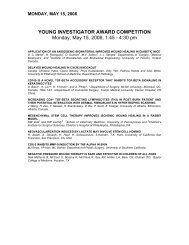

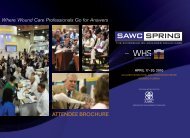

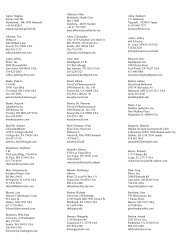
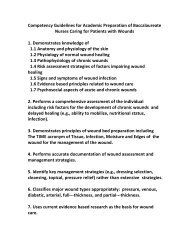
![2010 Abstracts-pah[2] - Wound Healing Society](https://img.yumpu.com/3748463/1/190x245/2010-abstracts-pah2-wound-healing-society.jpg?quality=85)